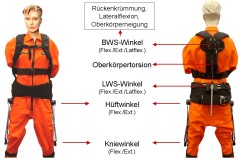- Artificial Intelligence (AI)
- Occupational exposure limit values
- Climate Change and Occupational Safety
- List of CMR substances
- Electromagnetic fields
- Ergonomics
- Industrial Security
- Collaborative robots
- Noise
- Nanoparticles at the workplace
- Optical Radiation
- REACH
- Reference materials
- Proficiency testing
- Vibration
- Virtual reality
- Work 4.0
Ergonomics
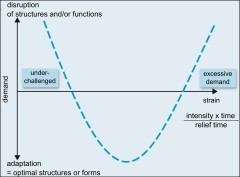
Distribution of strain: disruption/adaptation of structures and/or functions
Source: Hartmann, B., Spallek, M.: Arbeitsbezogene Muskel-Skelett-Erkrankungen. Eine Gegenstandsbestimmung. Arbeitsmed.Sozialmed.Umweltmed. 44 (2009) Nr. 8, S. 423-36
The term "ergonomics" is formed from the Greek words "ergon" (work) and "nomos" (science, law). It refers to the science of human work, i.e. the ideal adaptation of work to the characteristics and abilities of the working human being. The objectives of ergonomics are humaneness and cost-effectiveness (achieved for example through optimization of work processes), in consideration of occupational safety and health. In order for these objectives to be implemented in work design, ergonomics draws upon research and its findings in the fields of ergonomics.
Aspects of the ergonomic design of workplaces encompass environmental variables such as climate (light, radiation, temperature), colour, noise, vibration, human body dimensions (anthropometrics), and physical and mental stresses at the workplace.
The work of the IFA's Ergonomics Unit is focussed upon stresses upon the musculoskeletal system of the human body. This system, consisting of bones, muscles, ligaments, tendons, cartilage and connecting tissue, may be subjected to both excessive and insufficient stress. Musculoskeletal disorders (MSDs) account for around 20% to 25% of all working days lost due to unfitness for work. Around half of these are in turn due to back complaints and disorders.
Excessive stress upon the musculoskeletal system may for example be a result of lifting, carrying, pulling or pushing of loads, the performance of work in constrained postures, repetitive tasks, and work involving high force exertion. Insufficient stress may be caused by a lack of movement, as for example in office or driving work.
Key topics and selected current and completed projects:
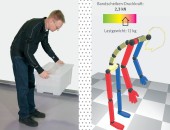
- The CUELA measuring system
- The CUELA measurement system (the German acronym "CUELA" stands for computer-based measurement and ...
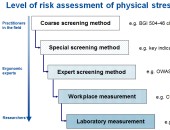
- MEGAPHYS: multilevel risk assessment of physical exposures
- The German Federal Institute for Occupational Safety and Health (BAuA) and the DGUV have agreed to ...
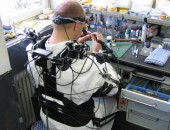
- Occupational musculoskeletal diseases of the upper extremities
- An epidemiological relationship and therefore a relationship to the work can be established ...
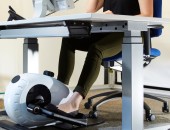
- Ergonomic studies during seated tasks
- Studies into the promotion of physical activity by means of dynamic office workplaces The number ...

- ErgoKita: Ergonomic design of workplaces in children's daycare facilities
- During their daily work, childcare professionals frequently experience high musculoskeletal ...
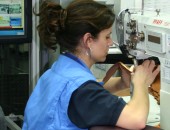
- Ergonomics at sewing workplaces
- An elevated sickness rate with corresponding absences from work has been observed for many years ...
Further information

Further projects
Sitzmemory am Busfahrerarbeitsplatz (Seat memory at bus drivers‘ workplaces):
IFA Report 3/2012
http://fahrersitz.ifa.dguv.de
Focus on IFA's work No 0119 (PDF, 135 KB)
(all in German*)
Der montagespezifische Kraftatlas (Force atlas for assembly operations):
BGIA-Report 3/2009 (in German*)
Belastung der Lendenwirbelsäule bei Schaufeltätigkeiten (Stress upon the lumbar spine during shovelling tasks):
BGIA-Report 4/2008 and
Handlungsanleitung: Ermittlung der Wirbelsäulenbelastung in BK-2108-Feststellungsverfahren (PDF, 57 kB, non-accessible) (both in German*)
Reduction of stress upon baggage handlers and ramp agents at airports
Focus on IFA's work No 0312 (PDF, 105 kB, non-accessible)
Muskel- und Skelettbelastungen beim Schieben von Servicewagen in Flugzeugen (Study on the strain on flight attendants from the pushing and pulling of trolleys aboard aircraft):
BIA-Report 5/2004 and
Focus on IFA's work No 0286 (PDF, 216 KB) (both in German*)
Wirbelsäulenbelastungen im Pflegebereich (Spinal loading in the nursing professions):
Focus on IFA's work No 0199 (PDF, 132 KB) (in German)
Ergonomics at call-centre workplaces
Focus on IFA's work No 0178 (PDF, 112 kB, non-accessible)
Ergonomic analysis of grinding tasks in structural steel engineering
Focus on IFA's work No 0177 (PDF, 289 kB, non-accessible)
Ergonomic redesign of a crane operator workplace in a waste incineration plant
Focus on IFA's work No 0164 (PDF, 120 kB, non-accessible)
Awkward body posture strain resulting from work on overhead high-voltage power lines
Focus on IFA's work No 0155 (PDF, 122 kB, non-accessible)
* summary of the reports also in English (in the download-file)
